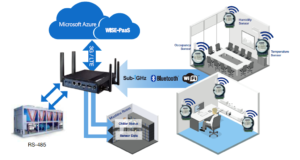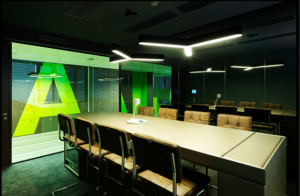Long gone are the days when employees sit all day in inflexible workspaces, adjusting themselves – and their needs – to the physical conditions of the workplace. The new model for the workplace no longer fits employees into a predesigned worksite but, using technology, redesigns the worksite to fit the needs of the employee. Just like our smartphones and smartwatches, our workplaces are being reinvented to be just as smart.
Smart buildings leverage big data, the Internet of Things (IoT), and intelligent Building Management Systems (iBMS) to assess the physical conditions of the workplace and adjust them to meet employee needs.
These tech systems facilitate and improve employee wellbeing and performance by modifying objects connected to the internet, such as light bulbs, heating, ventilation, and air conditioning systems, office chairs and desks, coffee machines, and even whole office spaces. Smart technology collects data from these objects and generates automated and controlled responses to improve an employee’s health and productivity.
Smart Heating, Ventilation, and Air Conditioning Systems
Smart HVAC systems are also a reinvention of the workplace, using AI to optimize air conditions and potentially save a lot of energy.
First, office spaces with very high or very low temperatures will impede efficiency at work and lead to fatigue and headaches. The same thing happens when the atmospheric CO2 levels are through the roof. This is where smart HVAC systems come in. Built with connected sensors that detect temperature, humidity, air quality, velocity, and flow rates, pollutant concentrations, and occupancy, smart HVAC systems optimize ventilation flow rates to fit demand in an office space.
Smart HVAC systems also communicate information about its energy consumption and efficiency, as well as mechanical defects in its components. Employers, energy grid managers, and maintenance staff can then use these details to adjust operational settings, such as on and off times, preheating duration, and temperature settings.
Smart HVAC systems also have smart thermostats that can help occupants control their building’s heating and cooling loads from a mobile app. These devices have been linked with an 8-10% drop in energy consumption. In a recent report by the American Council for an Energy-Efficient Economy (ACEEE), smart thermostats were linked up to 15% in energy savings.(https://www.buildup.eu/en/node/55333)
Smart Lighting Systems
Lighting is an essential part of the workplace. Reduced exposure to natural light at work may cause fatigue, moodiness, headaches, and even sleep disturbances. These not only compromise productivity but also lead to long-term health problems including depression and cognitive decline. Smart lighting systems can adjust the brightness and color temperature of office lightbulbs to imitate sunlight.
Smart lighting systems also work in sync with the body’s circadian rhythms, exposing a worker to the right amount of light needed to stay alert and active during the day.
Smart Office Space
The workspace of the future eliminates closed office spaces, unnecessarily long hours of working on a spot, and the attendant ergonomic problems of traditional office designs and installs connected workspaces that match office structure and conditions to the primary task at hand.
The smart workspace uses smart infrastructure including chairs and rooms that assess employee physical needs, room occupancy, and real-time location to optimize productivity and wellbeing.
These systems enable workers to know which rooms are unoccupied, which workstations fit the task for the day, and help them reserve spaces for specific times of the day. What’s more, smart office designs allow employees program lifts to be available for them at a specific time.
A New Way of Working
The future of work is employee-centric and the rise of the smart buildings typify that. Employees will no longer be made to fit into pre designed worksites, but, contrarily, workspaces will be crafted to adjust to our needs and optimize our performance. Ultimately, merging smart technology with office design not only promotes a more efficient and healthier workforce but it is also one of the most effective solutions for environmental sustainability.







Congratulations! keep on doing simple yet attractive designs. this is the best profession. keep on searching new ideas also related to interior designs.
Best Interior Design Company
Architects & Interior Designers
Thanx!
Great Article… I love to read your articles because your writing style is too good, it is very very helpful for all of us…
architecture
architecture firms in delhi
top architecture firms
top interior designers in delhi
The Benefits of Installing Switchable Smart Glass for Office Partitions
The Benefits of Smart Glass in a Smart home
Find amazing quality furniture with EasyMart Australia. They are known as the Office furniture manufacturers in Australia. Get the best price on each dealing of these boardroom table perth , chairs and many more. Great variety and amazing quality boardroom tables at the best price.
In this covid-19 period, the wellness of employees plays an important role in the continuous working of the industry. We organise virtual wellness activities for employees, in which our expert guide your remote employees about various physical and mental wellness activities.
Good Information, Keep sharing content like this.
Interior Design Agency in Dubai
Architectural Consultants in Dubai
Architecture Firms in Dubai
Top Architecture Firms in Dubai
Interior Design Services in Dubai
Architecture Design Services in Dubai